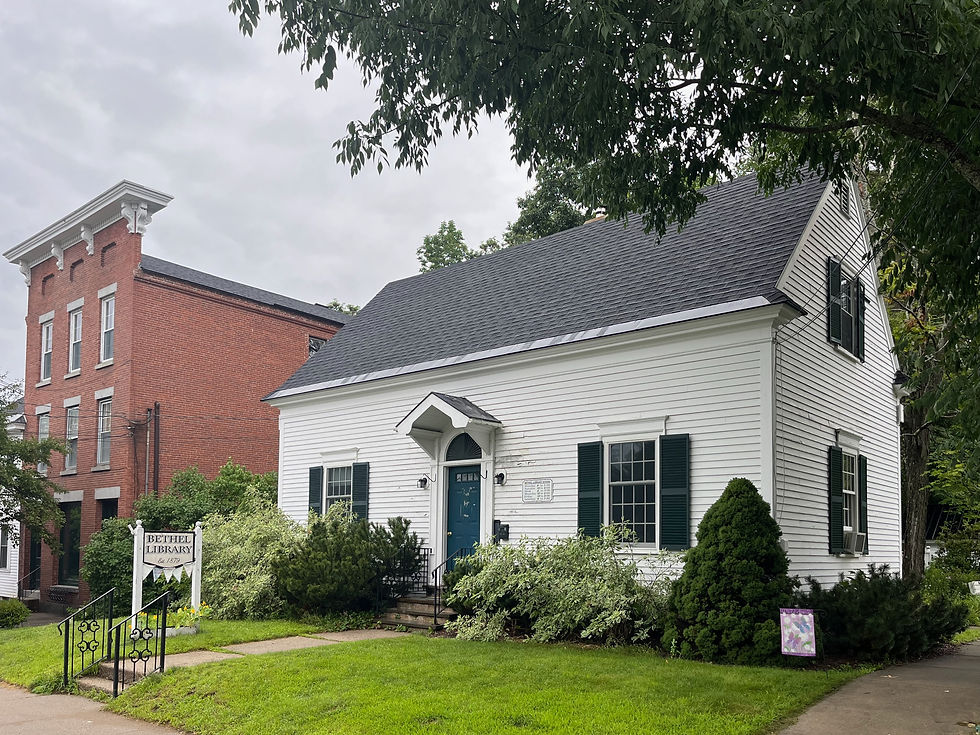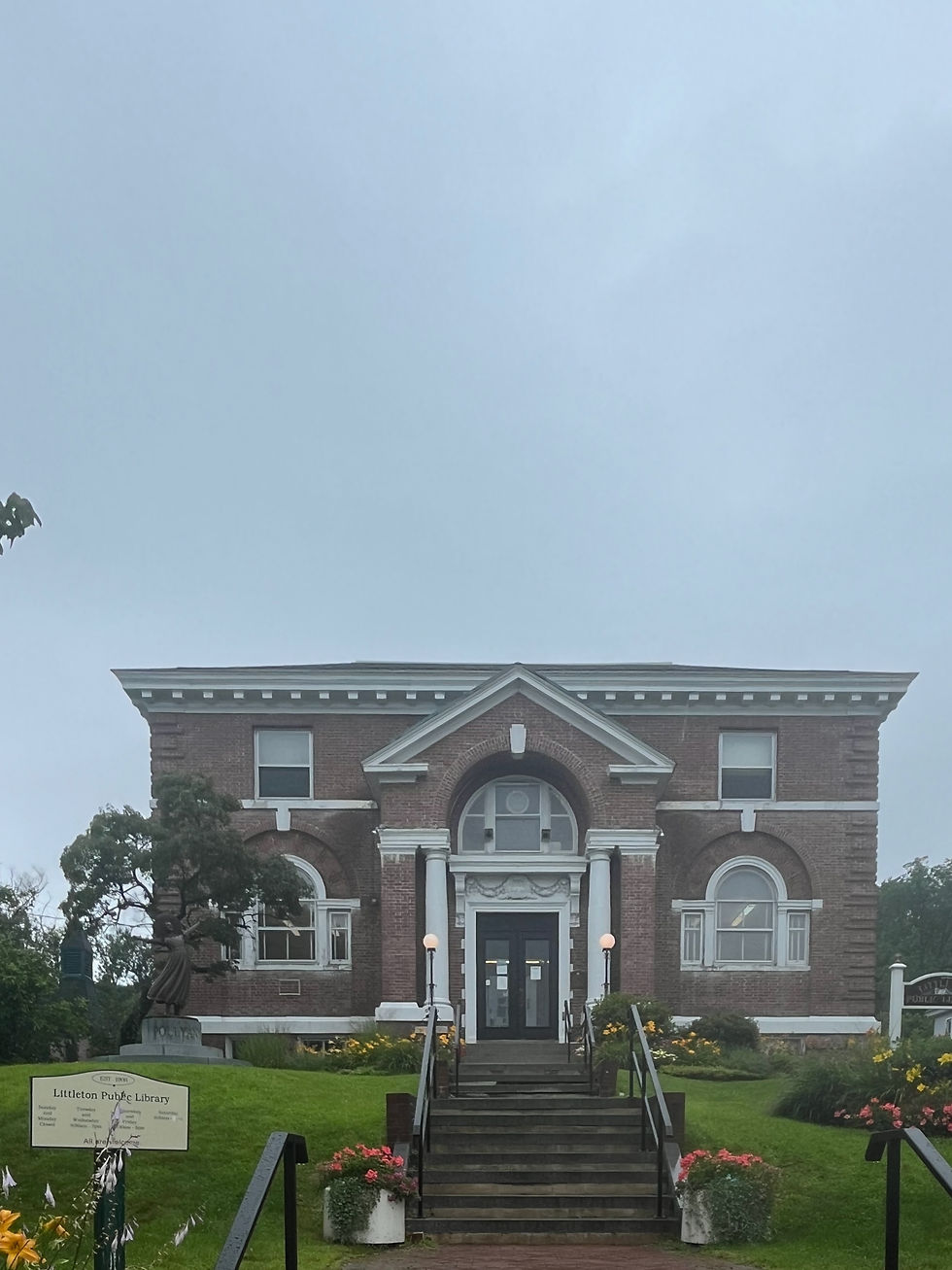Day 120, Wednesday July 24, 2024: Gorham, New Hampshire to Presque Isle, Maine
- Mark Carl Rom
- 20 hours ago
- 7 min read
Carnegie libraries visited: Rumford, Madison, Guilford, Milo, and Presque Isle, Maine
Days sober: 398
My head hurts, my feet stink, and I don’t love Jesus is the title of the Jimmy Buffett tune, and it aptly describes my morning, except for the Jesus part. I shouldn’t complain. When I popped open Goldfinger’s hatch, I’m greeted by the rippling waters of the Androscoggin. My itinerary calls for over 300 miles today, mainly on rural roads through Maine’s many villages, so after a cup from the McCafe I pushed off, north by northeast, entering Maine at Bethel and ending the day in Presque Isle, a Quebec-like lattitude.

JD Vance is three quarters right: “I had a Diet Mountain Dew yesterday and one today, and I’m sure they’re going to call that racist too…But—it’s good.” (The one wrong thing is that no one, really, is going to call anyone a racist because of their choice in highly caffeinated, artificially flavored, generously sugared, soft drinks.) Mountain Dew has long cultivated its outsider reputation as the drink of outsiders. Remember the old jingle “Yahoo, it’s Mountain Dew! It’ll tickle yore innards”? In 2024, Mountain Dew (the 5th most popular soda in the US (ahead of Coke Zero and Diet Pepsi; behind Sprite and Diet Coke) marketed itself heavily to snowboarders, mountain bikers, and gamers. Me? I had a Diet Mountain Dew yesterday, I’ll have another today, and it’s good. Besides, it has a goodly amount of caffeine (55 mg). A regular cup of coffee has about 95 milligrams. And to think I believed that I was “dewing” the highest caffeine drink on the market. I learn something everyday.
New England tends to preserve its Carnegie libraries; the Southeast, not so much. Vermont, New Hampshire, and Maine had a total of thirty-one Carnegies built, and only one is no longer a library (97 percent remain). Florida, Georgia, and North Caroline had forty-four libraries funded by Carnegie, and only ten (23 percent) of them continue in that capacity. Is it that the New Englanders cherish their library traditions in the way that the Southerners do not? Or is it that the South continues to grow and change – even at the price of demolishing parts of its history – while New England remains stuck in the past? I thought the South was especially proud of its heritage and unwilling to erase it. Maybe Carnegie libraries are not “past” enough?
The Bethel Library hosts a children’s storytime every Wednesday from 10-11, so that caregivers have at least one hour in the middle of the week with someone else reading to their children. I didn’t attend; I did enjoy knowing that it was happening. Who knows what’s happening at the Carnegie in Rumford: its website says that new programs are on their way so “stay tuned. ”




The Madison Public Library – more precisely, its Wikipedia page – was one of the inspirations for this book. The page, quite lengthy by small library standards, is mainly about the building itself, and not the people who made it possible. The anodyne sentence describing the library’s founding read “Madison’s public library traces its history to a meeting which was held on 04 January 1886 by local townspeople.” The library’s own history page is much more personal:
The idea of the formation and the founding of a public library in Madison originated with some ten or fifteen young ladies known as the "Ladies' Non-Sectarian Club" which was formed in 1885. Among its members were Ruth Manter, Alice Blake, Jennie Knowlton, Emma Manter, Addie Smith, Mable Simonds, Fannie Perkins, Ada Towne, Emma Heald, Nellie Moore and Gertrude Kent. On May 11, 1886, the Madison Library Association was formed. The first library was opened on Saturday, April 30, 1887 in a room on the second floor of the Towne Block, near the railroad crossing, and the first librarian [was] Miss Jennie Knowlton.
My complaint would have more force if my travelogue showed more pictures of librarians and fewer of libraries, right? I made the decision on my very first day not to ask librarians for their pictures to avoid the awkwardness of “Who, really, is this stranger who is asking for my picture? Just because he has a business card and flyer with America’s Libraries on them doesn’t exactly shout ‘trust him’.” Under the right conditions, many librarians will pose. The book This is What a Librarian Looks Like is filled with all sorts of wondrous portraits.
To make up for the fact that I haven’t been taking pictures, I am – like, right now, today, this very hour – learning how to properly edit Wikipedia pages and add citations to them. More of the women who have made America’s libraries are now included on the Madison page.
After more than a decade of moving around – the library had four different homes between 1887 and 1902 – librarian Jennie, who had in the meantime had gotten married to Charles Small, whose law office was one of the library’s hosts – appealed to Carnegie for a grant, writing that on behalf of “a library that ten of us young working people started thirteen years ago…We have worked hard for it, and are proud of what we have, but we want more…anything from one dollar up would be acceptable.”
Jennie Small was not the type to overpromise. In responding to the questionnaire’s query of how much money the town will raise through taxes to support the library, Small replies that “I think we could promise $500 all right. Possibly more, but not probable.” Bertram responded that Carnegie “has not been considering the building of libraries where a small amount like $500 per annum could be guaranteed…[but] any request by the authorities will receive consideration.” Small continued updating Bertram on the town’s progress and, sure enough, it voted to raise $500 annually as Jennie had guessed, and Carnegie did indeed write a check for $5000 (later raised to $8000). Madison’s Carnegie library opened in 1907. Jennie, sadly, was not able to enjoy it, as she died in 1906 at age 48.
The building, I’ll report, is cool, with an octagonal center and rectangular angled wings.

The Wilton Free Library, perched above Wilson Stream on Main Street, is where I would like to spend the rest of the day, if I could, but I can’t, or won’t, as it is only 10 a.m. and the library doesn’t open until noon. Nothing is going to keep me from gazing at it for a while, though, as I’m imagining what it must be like to work there. Wilton is open thirty one hours each week, from 10 - 5 on Tuesdays, Thursdays, and Fridays; from noon to 7 on Wednesdays, so it can accommodate those who can’t come before they get off work; and 10 - 1 Saturday for the weekend readers. It has a staff of five: Jennifer Scott is the Director, Cassandra Savage the Children’s Library, and Alison Duncan, Laura Savage, and Karin Schott are Library Assistants. In some future life, maybe I’ll join them.

The Piscataquis Observer observed, in 1908, that the Guilford Memorial (Carnegie) Library is “a plain but impressive looking structure…[with] a high elevation and…an excellent view of the surroundings.” That description still holds. Mrs. R.H. Marsh, the secretary of the library’s first board of trustees, wrote Mr. Carnegie in language less plain and less impressive: “Would you kindly inform me of the conditions under which Carnegie libraries are given?” After Carnegie awarded the town $5750 and the library opened in 1908, the Observer lauded its librarian, “Too much praise cannot be given Miss Ernestine Hale, the librarian, for her effort in bringing the library to where it now stands.” Hale and her assistant opened the library three days a week.
In 1986 the Guilford Memorial Library was added to the National Register of Historic Places, one of an unknown number of Carnegies to receive that honor (and protection). Making the register does not eliminate the need for continued improvements. Linda Packard was hired as librarian in 1992 and “that’s when things started really happening again” at the library. By the time Linda retired in 2014, she had been named Maine Librarian of the Year (2005) and had led Guilford to becoming one of the state's only five “Star” libraries. (You can read more about her in the Piscataquis Observer, “Covering Librarians for Over a Century!”) When asked what she wanted for her retirement, Linda asked only for a library card.

The history of the Carnegie library in Milo is like a puzzle whose pieces don’t quite fit together. In 1908, town officials requested a Carnegie grant and were quickly awarded $5000. Then: silence. In 1916, Mrs. Ida Perkins, President of the Alpha Reading Club (“membership limited to 25”) wrote to Carnegie saying that they, with the assistance of the Women’s Christian Temperance Union, had organized a free public library and that they urgently needed assistance (“What can you do to help?”). Perkins received a response (from someone else at the Carnegie Corporation, not Bertram) that if the town needed a library the mayor and council needed to make a formal request. No mention was made of the earlier agreement. In 1917 the town agreed to raise $700 annually in taxes in exchange for a $7000 grant. Again: all quiet.
Now, let me summarize the correspondence that followed. In 1920, Bertram wrote the mayor to tell him that, unless you get your act together, I’m taking the money back. Building Committee: World war, etc., we don’t have the money, can we make the library part of the town hall? Bertram: No. Building Committee: Are you sure? Bertram: Yes. Bertram (1921): Hey, Carnegie originally offered you money thirteen years ago, so unless you begin construction today, and spend some of your money first, the deal’s off. Building Committee: Ok, but we need more money. Bertram: No. Building Committee: All right, here are our plans. Bertram: They are not acceptable. Building Committee: Here is our new plan. Bertram: Better; still, “quite inferior.” Building Committee: We can’t find all of our previous correspondence. Bertram: “It would appear therefore that the first thing necessary is to adopt an attitude of mind which will come a willingness to profit by others’ experience.” Building Committee: “This leaves us at a standstill and we do not know what to do next.” Bertram: For God’s sake, just use an approved plan. You should have been done with this years ago. Building Committee: Ugh… Bertram: Here, take my plan. Building Committee: We can do that? Bertram: FFS. Building Committee: Can we have the money now? Bertram: Here, take it, and please leave me alone. The Milo Free Public Library opened, finally, and to the relief of all, in 1923.
I just want to sit by a lake and think while I watch the sunset. Thank you, Arnold Brook Lake, a generous slice of solitude a few miles outside Presque Isle.



















Comments